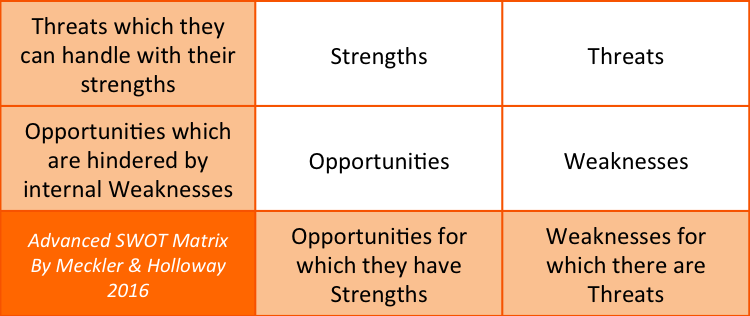Advanced SWOT Analysis
By Mark Meckler, Ph.D., September 6, 2016
Strategy Short by Mark Meckler, Ph.D. - Added September 12, 2016Dr. Mark Meckler introduces an elegant and short 5-minute video that walks our members through the process of generating strategic alternatives, which is a classic outcome of traditional SWOT Analyses. However, we go further and tell the strategist "how" to choose among those alternatives, which is the difference between traditional SWOT and our Advanced SWOT. Leveraging Dr. Richard Rumelt's expertise on how to select among strategic alternatives, we give our members the tools they need to make hard choices in an ever-changing craft beer business environment. |
|
SWOT analysis is a basic task of discerning and discussing strengths, weaknesses, opportunities and threats. I advise the use of an advanced SWOT matrix that forces conscious matching of Strengths and Weaknesses, on the one hand, with Opportunities and Threats on the other.
Most of the time, I recommend the first priority of the organization should be to assign resources to material threats that can be handled with current strengths. There is no good excuse for getting knocked down by something you easily could have avoided. An organization’s second priority should be acting on opportunities that can be realized by utilizing existing strengths. Your third priority is shoring up weaknesses for which there are significant immediate threats. Fourthly, the organization should evaluate and position for opportunities that can be taken advantage of by acquiring new strengths. Last, the organization focuses on shoring up weaknesses for which there are significant non-immediate threats. We depict these priorities in Figure 1.

Figure 1: Advanced SWOT Analysis Matrix
This order of priority is optional and strategic intent can and should alter one’s priorities. For example, acquiring new strengths can be expensive (that is, require a large amounts of resources) and will usually carry more risk than the other categories of strategic priority. An example is spending $500,000 on a new canning line, automatic de-palletizer, extra real estate to store cans, and installation of the canning line. While this large expense may be a long-term goal, it may not seem urgent in the face of other challenges that can be overcome with fewer resources. (For a discussion of how and why it makes sense to spend money on a canning line, see our white paper: What Are Transaction Costs.) Companies should evaluate their acquisition of new competencies by examining the tradeoffs between return on investment and elevated levels of risk. Increased risk means both increased chance of large returns as well as increased chance of large losses.
In his book “The Effective Executive;” the great Peter Drucker emphasizes that managers are far better off focusing on the pursuit of opportunities and making use of their strengths than they are worrying about and shoring up weaknesses.[i] In the first place, those who pursue opportunities with their current strengths and who develop new strengths often make their weaknesses unimportant. Also, by moving forward, situations that were threats are often left behind. Drucker claims businesses that focus on shoring up weaknesses rather than bold pursuits of opportunities are destined for mediocrity.
Typically an organization must act on all of the above strategic categories. Some portion of the resource budget must go to each. These are strategic commitments and the amounts allocated to each category are determined by the administration. For more information on how to balance strategic choices, see our white paper: What Is Strategy at CAS?
Advanced SWOT Analysis Example
In the example below, we evaluated a mid-sized Pacific NW (USA) brewpub chain that asked us not to use their real name. We will call them Cascadia Brewing (CB). The president of CB made the mistake of consistently putting priority on taking advantage of opportunities by solely acquiring strengths, a practice that is decidedly risky. Of course, businesses must take the risk of acquiring new strengths, as existing strengths will tend to become obsolete over time. However, management has to protect the firm from dangerous immediate threats, and also must be certain to gain all the economic rents (profits) it can from the value of the strengths that it already possesses. We cautioned this seasoned president that their focus in one area of the Advanced SWOT matrix was exposing them to unnecessary risk.

The important point here is not our particular findings, rather how a strategist goes about using the framework.
- First, fill out the internal analysis stuff – that means the firm’s strengths and weaknesses.
- Next, fill out the external analysis stuff – that means the opportunities and the threats uncovered during the industry analysis (like Porter’s Five Forces analysis) and the broader environment as well (like a STEEP trend analysis).
- Then simply work across rows to match threats with strengths and then opportunities with weaknesses. Then work down the columns to match strengths with opportunities and threats with weaknesses.
- Finally it is up to the leaders to prioritize what to plan for, what to act upon and when.
[i] Drucker, Peter F., 1966. “Chapter 4: Making Strength Productive.” In The Effective Executive; Harper & Row Publishers, New York, NY USA.

